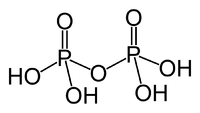
Photo from wikipedia
Apart from the SARS-CoV-2 virus, tuberculosis remains the leading cause of death from a single infectious agent according to the World Health Organization. As part of our long-term research, we… Click to show full abstract
Apart from the SARS-CoV-2 virus, tuberculosis remains the leading cause of death from a single infectious agent according to the World Health Organization. As part of our long-term research, we prepared a series of hybrid compounds combining pyrazinamide, a first-line antitubercular agent, and 4-aminosalicylic acid (PAS), a second-line agent. Compound 11 was found to be the most potent, with a broad spectrum of antimycobacterial activity and selectivity toward mycobacterial strains over other pathogens. It also retained its in vitro activity against multiple-drug-resistant mycobacterial strains. Several structural modifications were attempted to improve the in vitro antimycobacterial activity. The δ-lactone form of compound 11 (11') had more potent in vitro antimycobacterial activity against Mycobacterium tuberculosis H37Rv. Compound 11 was advanced for in vivo studies, where it was proved to be nontoxic in Galleria mellonella and zebrafish models, and it reduced the number of colony-forming units in spleens in the murine model of tuberculosis. Biochemical studies showed that compound 11 targets mycobacterial dihydrofolate reductases (DHFR). An in silico docking study combined with molecular dynamics identified a viable binding mode of compound 11 in mycobacterial DHFR. The lactone 11' opens in human plasma to its parent compound 11 (t1/2 = 21.4 min). Compound 11 was metabolized by human liver fraction by slow hydrolysis of the amidic bond (t1/2 = 187 min) to yield PAS and its starting 6-chloropyrazinoic acid. The long t1/2 of compound 11 overcomes the main drawback of PAS (short t1/2 necessitating frequent administration of high doses of PAS).
Journal Title: ACS infectious diseases
Year Published: 2022
Link to full text (if available)
Share on Social Media: Sign Up to like & get
recommendations!